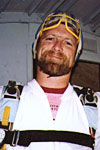© 2009 Pat Swovelin, All Rights Reserved.
67 years ago, brave men, very brave men, from diverse locations and socioeconomic status across the country joined the USAAF (United States Army Air Forces) to defend the United States during World War II. One of the positions in either a B-17 or a B-24 bomber was the ball turret gunner. His job was to defend the entire bottom hemisphere of airspace below the aircraft from enemy fighter attack (no pressure). Some of the other guns in the aircraft were able to depress their fire but not completely vertically like a ball turret could (a ball turret could rotate 360° and tilt -90°).
A diminutive crew member would volunteer, or be "volunteered," to be the ball turret gunner. A Sperry Ball Turret, like this one, has an outside diameter of 3', so the gunner not only needed to be physically small but had to be curled up in a fetal position for hours on end (sometimes 10-12 hours on a long mission) while in the turret. As the aircraft approached enemy airspace (above diverse countries in both the European and Pacific Theaters) where fighters were expected to attack them, the ball turret would be tilted down 90° to allow access to the hatch on the front of the sphere. The gunner would step down into the ball turret, put his boots in the heel cups (you can see them beside and below the round window), squat down and strap himself in. Then the hatch was closed and he would rotate the ball turret back to the horizontal position putting him in a fetal position on his back. The turret was operated electrically with hand controls and he would look between his legs and feet and through a sight hanging in front of the 13" round window you see in front of you.
As if it weren't cramped enough in a 3' sphere there were 2 .50 caliber machine guns (with only 250 rounds of ammunition apiece, incredibly none of the 13 .50 caliber machine guns on the plane carried more than a minute's worth of ammunition) and all of the controls necessary to operate everything. There was room for a first aid kit (like a first aid kit will help you after being hit by flak or cannon fire from attacking aircraft) but not for a parachute. If the plane was shot down (or broke) and the pilot gave the command to bail out, the gunner had to tilt the ball turret down 90° to be able to get out and back into the aircraft where his QAC (Quick Attachable Chute) was stored, clip it onto the harness he was wearing and get out through a hatch or the bomb bays (if the doors were open). All of this while the plane was spinning/tumbling with G-forces high enough to pin him against the wall, trapping him in the aircraft until impact.
The chances of him being able to get out, slim and none.
That having been said, statistically the safest crew position in a B-17 was the ball turret gunner; the most hazardous was the pilot. Having shot and crawled all through this plane, the ball turret gunner, the bombardier, the tail gunner and the pilots would be hard pressed to get out in time.
The Death of the Ball Turret Gunner
From my mother's sleep I fell into the State,
And I hunched in its belly till my wet fur froze.
Six miles from earth, loosed from its dream of life,
I woke to black flak and the nightmare fighters.
When I died they washed me out of the turret with a hose.
— Randall Jarrell
This Sperry ball turret is in the B-17G Liberty Bell, owned and operated by the Liberty Foundation of Tulsa, Oklahoma. A big thanks and a tip of the hat to Scott Maher (Director of Operations/Media Relations) and Tim Bourgoine (Director of Maintenance) for allowing me unfettered access to the Liberty Bell when I showed up out of the blue with a wild story about how cool shooting VR in the ball turret (and bombardier's position and the tail gunner's position) would be.
There are only 13 B-17s still flying today and I urge you to go to a local airshow if one of them will be there. They are magnificent aircraft and truly living history museums.
Lat: 34° 12' 1.57" N
Long: 119° 22' 55.94" W
Elevation: 736 feet MSL, 2 feet AGL
Precision is: High. Pinpoints the exact spot.



 Tap or click the zoom icon in the bottom right corner of the picture to switch between in-page and fullscreen view
Tap or click the zoom icon in the bottom right corner of the picture to switch between in-page and fullscreen view